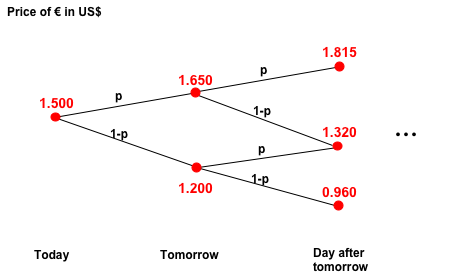Cox, Ross and Rubinstein developed the Binomial
Model in
1979,
which is also known as the CRR model.
We will first present it through some examples before explaining the
general case.
Example 1: One step model
Suppose that today €1=$1.5. Assume that you know
that
tomorrow the Euro
will be worth either $1.2 with probability
1-p or $1.65 with probability p.
Assume also that you can borrow or lend money in dollar currency
at a fixed interest rate of 10%. Under these circumstances the
market that you are facing can be modeled by a one step binomial
model. One step because you are only given information about the
Euro value tomorrow, binomial because there are only two possible
values of the Euro tomorrow. The assumption that you can borrow or lend
money at a fixed interest rate is a common assumption in
short term financial models.
Example 2: Multistep Model
A natural generalization to the situation
presented in
the
previous example arises when you face such a problem on a daily
basis for a determined period of time. For example, suppose that
today €1=$1.5 and for any given day of the month the
probability of the price of the Euro to go down by 20% is
1-p while the probability of the price
going
up by 10% is
p. As before assume that you can borrow
or
lend money at a
fixed daily interest rate of 10%. In this case the market can be
modeled by a multistep binomial model and the best way of
visualizing such a model is through a binary tree like the one
shown below.

The general case
The CRR model with time horizon T
involves a
riskless bond (which can be interpreted
as a money
market account or T-bonds)
and a risky asset (e.g. stocks, bonds, commodities such as oil or gold,
currency exchange rate, pork bellies etc.). The price process of the
riskless bond is

with r > -1. The price
process of the risky
asset is denoted by
St for t=0,1,...,T
where

with Rt
the
return in the the tth trading period.. The return Rt
can only take two possible values -1 < a < b.
This implies that the price of the risky asset at any time t,
either jumps to
the higher value St (1+b) or
to the lower value
St (1+a).
Example 2 (continued)
The action of borrowing
risky
assets and
selling them immediately is called Selling short.
Investors who believe the price of an asset is going to drop will short
sell this asset.
We have in this case that the riskless bond is the
dollar, the
risky asset is the Euro, T is the number of days
remaining
in the month, r=0.1, a=-0.2 and
b=0.1.
Suppose further that you can borrow Euros with no interest, that
p=0.5 and that there is only one day
left in
the month (so that
you are facing a one step situation). You could take advantage of
this circumstance by using the following strategy: borrow one
Euro today, sell it immediately for $1.5 and lend this money
(see Tangent). Tomorrow you will get for sure $1.65, since
the interest rate is 10%. If the price of the Euro goes up to
$1.65 you use your money to buy an Euro and pay your debt
obtaining a net gain of $0. If the price of the Euro goes down to
$1.2, you buy an Euro to pay your debt but in this case your
ending balance is $1.65-$1.2=$0.45. Hence by following this
strategy you can make $0.45 with a probability of 0.5 and no risk. Of
course you could do the same with an arbitrary amount of Euros in
the beginning, which generates even greater gains.
Activity 1:
- Assume
you are facing the
situation presented in the last example but there are two days
left in the month instead of just one. Find a strategy such that
the net gains are always nonnegative and positive with positive
probability.
- Can you find such a
strategy if the interest rate r is 5% instead of
10%?
Activity 2:
- The price of one gallon
of gasoline on January 1st is $4. On January
2nd this price can either go up to $4.40 or go
down to
$3.60 with the same probability. If the interest rate r
is
20%, can you find a strategy such that on January 2nd
the net gains are always nonnegative and positive with positive
probability?
- Suppose that the same
pattern holds until January 4th. Draw a binary
tree
modelling the market. Can you find a strategy such that on
January 4th the net gains are always nonnegative
and
positive with positive probability?
- What happens if the
interested rate r is equal to 0?
Note:
Assume
that you can short
sell gasoline.
The situations presented in the previous examples
give
rise to the
following question: under which circumstances is it possible to
find a strategy to beat the market, in the sense that by
following such strategy at time T you will have a positive profit
with positive probability and no risk? We discuss this issue in the
next lessons.